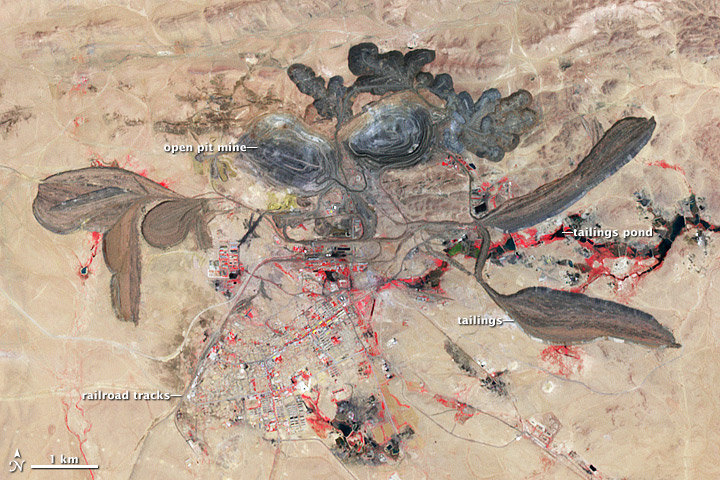
Clean technologies depend upon raw materials from mining operations such as the one pictured above in northern China. The black regions are sites of toxic waste created by the mining process. These toxins leach into local soils and foods, and eventually pollute the bodies of local residents.
Green, renewable, and sustainable. These words are frequently used to describe the solar panels, wind turbines, and electric cars that will fuel the future’s energy industry. But did you know that these “clean” technologies are responsible for increased rates of leukemia, mental disability, and toxic poisoning? While green technologies do not pollute the air like a coal-fired power plant, their manufacture requires toxic materials that threaten the health of local mining communities. These toxic materials are known as rare earth elements (REEs), seventeen specialized metals with unique physical and chemical properties. The services provided by the toxic REEs are so unique that no substitutes exist to replace them, meaning they remain essential components of many green technologies.
Despite their name, rare earth elements are not “rare” at all. In fact, they are more common than gold and can be found throughout the Earth’s crust. REEs are “rare” because they exist in concentrations so low that they are difficult to extract profitably. Only a few countries—such as Russia, Brazil, China, and the U.S.—possess deposits with REE concentrations high enough for human use. Unfortunately, mining these deposits poses both environmental and human health risks. The mining wastes contain traces of the toxic REEs. REEs are chronic toxins – that is, over the course of many years, they pollute the kidneys, liver, and lungs.
In 2013, a new study by China’s Fujian Normal University became one of the first to directly quantify the human health threats posed by REE mining operations. To do this, the study surveyed a farming community in southeast China (Fujian Province) that is adjacent to a REE mining facility. Health concerns related to REE mining are particularly pertinent to China, which supplies 86% of the world’s REEs and lacks adequate implementation of environmental and health safety regulations. The study compared the presence of REEs in the environment (soil, crops, and water wells) with REE concentrations in the bodies of local residents who ate locally grown produce (human hair and blood samples).
The study found that Fujian’s soils had high concentrations of toxic REEs, compared to areas without mining operations. Over half of the toxic waste in Fujian’s soil pose little risk to human health, because they attach to clay minerals in the earth. The other half, however, is bio-available; that is, REEs can be freely absorbed by vegetation. As such, locally grown crops absorb some, though not all, of the REEs present in the soil. The study found that local crops in the surveyed area had elevated levels of REE, though not at concentrations above estimated daily intake. Daily intake is the suggested amount of pollutant that is deemed “safe” for human consumption. Certain vegetables with high water contents, such as taro and water spinach, had much higher levels of REE compared with other locally grown foods. While these levels are low, long-term exposure may still cause significant harm, especially to children and infants, who are more vulnerable to the effects of toxic chemicals.
Much like the deadly chemical DDT, REEs can be particularly dangerous toxins because they persist in the bodies of living things for years at a time. This process is known as bioaccumulation, and is particularly dangerous, because plants and animals, including humans, can collect small, harmless doses of chemicals in their bodies over a period of years, until the concentration of chemicals becomes harmful. This is why human breast milk is considered slightly toxic: chemicals that the mother bioaccumulated throughout her lifetime can transfer to her infant through breast milk. Similarly, REEs can persist in the human body for over fifteen years.
The Fujian study demonstrates that while consuming crops with REE concentrations may not be dangerous on a daily basis, the chronic accumulation of REE over many years, especially for young children, presents significant health risks. These risks are already surfacing at Fujian: local residents had elevated REE concentrations in their blood and hair samples. Other environments more heavily polluted by REE mining may already be at risk of health damages, including lower kidney functioning and lung disease. For example, in northern China, where two-thirds of REE mining and processing takes place, REE concentrations in local soils were up to 130 times greater than polluted soils in Fujian.
Unfortunately, toxic REEs can enter the body from many sources. These “exposure pathways” include eating contaminated food, drinking polluted water, and breathing or touching REE particles in the air. While REE pollution from only one of these sources may be considered “safe,” the cumulative impacts of multiple sources pose significant threats to human health. For example, in one East Asian mining community, some houses were just 20 meters away from REE manufacturing facilities. After the mine’s arrival, a significant number of community members contracted, and died from, leukemia, and several local children were born with severe mental disabilities.
On a global scale, green technologies promise to address serious environmental problems, such as global warming, by cutting the carbon emissions from dirty industries. However, are these technologies really “green” if they depend upon the pollution of local communities? To be truly “clean,” solar panels and wind turbines cannot ignore their origins. A green and healthy future should be available to all communities.